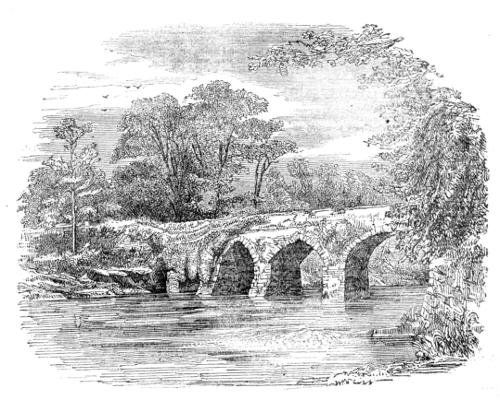THE IRISH PENNY JOURNAL.
| Number 17. | SATURDAY, OCTOBER 24, 1840. | Volume I. |

NEW BRIDGE, COUNTY OF KILDARE.
It is a curious circumstance, that while among the mosthumble and illiterate, as well as among the high and educatedclasses of society in Ireland, a certain degree of interestand respect is usually felt for the ecclesiastical and militaryremains of past ages, those of a purely useful character, asancient bridges for example, excite no corresponding sentiments,and are destroyed without causing the slightest feelingof regret in the minds of any portion of society. Strange,however, as this may appear, the fact is undeniable, as therecent destruction of Thomond Bridge at Limerick, and theintended destruction of other ancient bridges on that nobleriver and elsewhere, sufficiently testify; and in a few yearsmore there will, in all probability, scarcely remain in thecountry a single example of monuments of this class. Yet itcannot be said that such memorials of the progress of civilizationin past ages are without their hallowing associations,or that their moss-stained and ivy-mantled arches are lesspleasing to the lover of the picturesque than those of theruined castle, church, or abbey. Who that has ever seen theancient bridge of Limerick, with its fifteen arches, exhibitingevery variety of form, its horizontal line contrasting soadmirably with the upright forms of the adjacent objects, andcalling up in the mind recollections of the finest landscapes ofClaude—who, we say, that has enjoyed this pleasure of arefined taste, but will hear testimony to the truth of ourassertion, and regret the circumstances which have givenbirth to it? Who, in like manner, that has ever seen the ancientbridge which forms the embellishment of our presentnumber, but would deeply lament its destruction? Yet suchwas the fate to which it was doomed, but a few years since, bya county grand jury, and from which it only escaped throughthe influence of the worthy proprietor of St Woolstan’s,Richard Cane, Esq., who, in a spirit equally honourable to histaste and his nationality, declared that sooner than permitso interesting a monument of antiquity to be destroyed, hewould build a new bridge at his own expense. Alas! that wehave not amongst us a greater number of gentlemen of histaste, wealth, and spirit!
Despite of its contradictory name, New Bridge is theoldest bridge now remaining on the beautiful Liffey, and,with the exception of the ancient Bridge of Dublin, which wastaken down and rebuilt some years since, is probably the first[Pg 130]bridge of stone ever erected on it. From Pembridge’s Annals,as published by the Father of British antiquaries, WilliamCamden, we learn that this bridge was erected in the year1308, by John le Decer, the Mayor of Dublin in that year,at his own expense. So that by a curious and not uninterestingcoincidence, it owes its erection to one worthy andpatriotic citizen of Dublin, and its preservation, after a lapseof more than five hundred years, to another.
New Bridge is situated in the barony of North Salt, aboutone Irish mile south-west of the town of Leixlip. It consistsof four arches, some of which are semicircular and otherspointed; and, like most ancient bridges, it is high and extremelynarrow. Mantled with luxuriant ivy, and enrichedwith the varied and mellow tints of so many ce